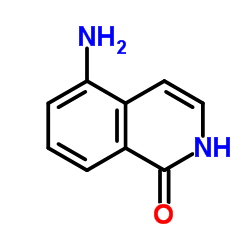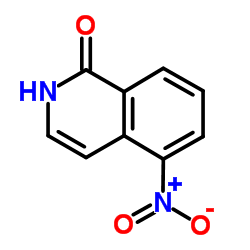5-Aminoisoquinolin-1(2H)-one
Modify Date: 2024-01-10 13:19:13

5-Aminoisoquinolin-1(2H)-one structure
|
Common Name | 5-Aminoisoquinolin-1(2H)-one | ||
|---|---|---|---|---|
| CAS Number | 93117-08-9 | Molecular Weight | 160.173 | |
| Density | 1.3±0.1 g/cm3 | Boiling Point | 477.3±45.0 °C at 760 mmHg | |
| Molecular Formula | C9H8N2O | Melting Point | N/A | |
| MSDS | N/A | Flash Point | 242.4±28.7 °C | |
Use of 5-Aminoisoquinolin-1(2H)-one5-AIQ (5-Aminoisoquinolin-1-one) is a water-soluble PARP-1 inhibitor. 5-AIQ is an important functional group in various drugs. 5-AIQ reduces the tissue injury associated with ischemia-reperfusion of the liver, it can be used for the research of the therapy conditions associated with ischemia-reperfusion of the liver[1][2]. |
| Name | 5-Aminoisoquinolin-1(2H)-one |
|---|---|
| Synonym | More Synonyms |
| Description | 5-AIQ (5-Aminoisoquinolin-1-one) is a water-soluble PARP-1 inhibitor. 5-AIQ is an important functional group in various drugs. 5-AIQ reduces the tissue injury associated with ischemia-reperfusion of the liver, it can be used for the research of the therapy conditions associated with ischemia-reperfusion of the liver[1][2]. |
|---|---|
| Related Catalog | |
| Target |
PARP-1 |
| In Vitro | 5-AIQ (5000 μg) significantly reduces the number of colonies of TA 98 without metabolic activation, and TA 98 and TA 1537 with metabolic activation[1]. |
| In Vivo | 5-AIQ (150 and 250 mg/kg; p.o.; once) possess no significantly genotoxic in vivo system by micronucleus test[1]. 5-AIQ (3 mg/kg; p.o.; 5 min prior to onset of liver ischemia) reduces the tissue injury associated with ischemia-reperfusion of the liver[2]. Animal Model: Male mice[1] Dosage: 150 and 250 mg/kg Administration: Oral gavage; 150 and 250 mg/kg; once Result: Showed no increase of micronucleated polychromatic erythrocytes (MNPCE) in both 24 h and 48 h after both 125 and 250 mg/kg duration exposure as compared to the corresponding control. Animal Model: Anesthetised male Wistar rats with liver ischemia (for 30 minutes) and reperfusion (for 2 hours) [2] Dosage: 3 mg/kg Administration: Intravenous injection; 3 mg/kg; 5 min prior to onset of liver ischemia Result: Reduced PARP activation and showed less staining for ICAM-1. |
| References |
| Density | 1.3±0.1 g/cm3 |
|---|---|
| Boiling Point | 477.3±45.0 °C at 760 mmHg |
| Molecular Formula | C9H8N2O |
| Molecular Weight | 160.173 |
| Flash Point | 242.4±28.7 °C |
| Exact Mass | 160.063660 |
| PSA | 58.88000 |
| LogP | -0.15 |
| Vapour Pressure | 0.0±1.2 mmHg at 25°C |
| Index of Refraction | 1.657 |
|
Material Safety Data Sheet
Section1. Identification of the substance Product Name: 5-Amino-2h-isoquinolin-1-one Synonyms: Section2. Hazards identification Harmful by inhalation, in contact with skin, and if swallowed. Section3. Composition/information on ingredients. Ingredient name:5-Amino-2h-isoquinolin-1-one CAS number:93117-08-9 Section4. First aid measures Skin contact:Immediately wash skin with copious amounts of water for at least 15 minutes while removing contaminated clothing and shoes. If irritation persists, seek medical attention. Eye contact:Immediately wash skin with copious amounts of water for at least 15 minutes. Assure adequate flushing of the eyes by separating the eyelids with fingers. If irritation persists, seek medical attention. Inhalation:Remove to fresh air. In severe cases or if symptoms persist, seek medical attention. Ingestion:Wash out mouth with copious amounts of water for at least 15 minutes. Seek medical attention. Section5. Fire fighting measures In the event of a fire involving this material, alone or in combination with other materials, use dry powder or carbon dioxide extinguishers. Protective clothing and self-contained breathing apparatus should be worn. Section6. Accidental release measures Personal precautions: Wear suitable personal protective equipment which performs satisfactorily and meets local/state/national standards. Respiratory precaution:Wear approved mask/respirator Hand precaution:Wear suitable gloves/gauntlets Skin protection:Wear suitable protective clothing Eye protection:Wear suitable eye protection Methods for cleaning up: Mix with sand or similar inert absorbent material, sweep up and keep in a tightly closed container for disposal. See section 12. Environmental precautions: Do not allow material to enter drains or water courses. Section7. Handling and storage Handling:This product should be handled only by, or under the close supervision of, those properly qualified in the handling and use of potentially hazardous chemicals, who should take into account the fire, health and chemical hazard data given on this sheet. Store in closed vessels. Storage: Section8. Exposure Controls / Personal protection Engineering Controls: Use only in a chemical fume hood. Personal protective equipment: Wear laboratory clothing, chemical-resistant gloves and safety goggles. General hydiene measures: Wash thoroughly after handling. Wash contaminated clothing before reuse. Section9. Physical and chemical properties Appearance:Not specified Boiling point:No data No data Melting point: Flash point:No data Density:No data Molecular formula:C9H8N2O Molecular weight:160.2 Section10. Stability and reactivity Conditions to avoid: Heat, flames and sparks. Materials to avoid: Oxidizing agents. Possible hazardous combustion products: Carbon monoxide, nitrogen oxides. Section11. Toxicological information No data. Section12. Ecological information No data. Section13. Disposal consideration Arrange disposal as special waste, by licensed disposal company, in consultation with local waste disposal authority, in accordance with national and regional regulations. Section14. Transportation information Non-harzardous for air and ground transportation. Section15. Regulatory information No chemicals in this material are subject to the reporting requirements of SARA Title III, Section 302, or have known CAS numbers that exceed the threshold reporting levels established by SARA Title III, Section 313. SECTION 16 - ADDITIONAL INFORMATION N/A |
| HS Code | 2933790090 |
|---|
|
~89% 
5-Aminoisoquino... CAS#:93117-08-9 |
| Literature: Rehwinkel, Hartmut; Baeurle, Stefan; Berger, Markus; Schmees, Norbert; Schaecke, Heike; Krolikiewicz, Konrad; Mengel, Anne; Nguyen, Duy; Jaroch, Stefan; Skuballa, Werner Patent: US2005/131226 A1, 2005 ; Location in patent: Page/Page column 8-9 ; |
|
~% 
5-Aminoisoquino... CAS#:93117-08-9 |
| Literature: US5177075 A1, ; |
| Precursor 2 | |
|---|---|
| DownStream 0 | |
| HS Code | 2933790090 |
|---|---|
| Summary | 2933790090. other lactams. VAT:17.0%. Tax rebate rate:9.0%. . MFN tariff:9.0%. General tariff:20.0% |
| 5-Amino-1(2H)-isoquinolinone |
| 5-Amino-2H-isoquinolin-1-one |
| 5-Aminoisoquinolin-1(2H)-one |
| 1(2H)-Isoquinolinone, 5-amino- |



